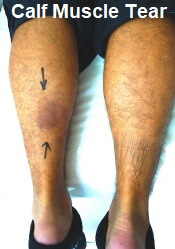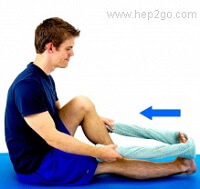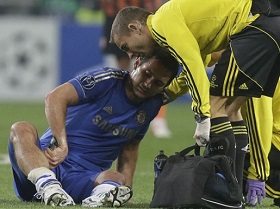- Home
- Common Knee Injuries
- Calf Tear
Pulled Calf Muscle
Written By: Chloe Wilson, BSc(Hons) Physiotherapy
Reviewed by: KPE Medical Review Board
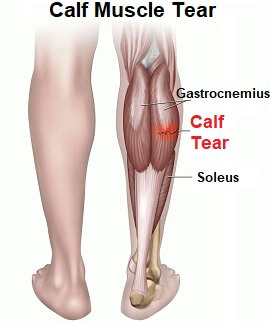
A pulled calf muscle is a really common sporting injury that can cause long-term problems if not effectively managed.
Other common terms for this injury include a calf muscle strain, calf tear and torn calf muscle.
Essentially, what all these terms refer to is one of the calf muscles being pulled beyond its normal elastic limit, overstretching it and damaging some or all of muscle fibers.
With a calf strain there is usually sudden, intense pain, the area may be tender to touch with swelling and bruising and walking is often difficult. A pulled calf muscle is the most common cause of calf pain and swelling.
Here we will look at what muscles make up the calf complex, how they are injured, the common symptoms experienced, what the best treatment options are and how to prevent yourself from suffering from a pulled calf muscle.
Calf Muscle Anatomy
The calf is made up of two muscles, gastrocnemius and soleus.
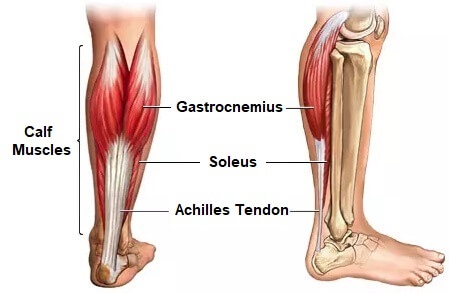
- Soleus: is the deep calf muscle that arises from just below
the knee joint
- Gastrocnemius: is more superficial, sitting over the top of the soleus muscle and arises from just above the knee.
They work together to pull the foot downwards into plantarflexion e.g. pointing your toes or lifting your heel up off the floor.
Both muscles join together around the mid-calf level to form the Achilles tendon which attaches the calf to the foot at the back of the heel.
The calf muscles play an important role when the foot is pushing off the ground when walking, running and jumping, and they help to stabilise the ankle.
Pulled Calf Muscle Causes
A pulled calf muscle usually happens suddenly due to injury, but can develop gradually from overuse. A calf muscle strain most commonly affects the larger, more superficial gastrocnemius muscle but can affect the soleus muscle as well.
Common causes of a pulled calf muscle are:
- Overstretching: Acute calf muscle strains occur when the muscle is suddenly overstretched, usually when changing direction or accelerating e.g. sprinting or jumping.
- Sudden Acceleration: Athletes participating in sports such as tennis, basketball, football, soccer or track events often suffer from calf muscle tears due to the sudden bursts of speed required when moving from a stationary position.
- Repetitive Overuse: Calf muscle strains can also developed due to repetitive overuse of gastrocnemius and soleus, usually with running and jumping, especially if the muscles are weak or tight. A calf strain is the most common cause of calf pain in runners.
Calf Strain Symptoms
There are three grades of calf muscle strain, depending on how much of the muscle is damaged and the location of the pain will depend on where the calf tear is.
- Upper Calf Tear: damage near the junction between the muscle tendon and muscle belly
- Mid Calf Tear: indicates a tear in the muscle belly and
- Lower Calf Tear: typically from damage to the achilles tendon
Typical symptoms for each grade of pulled calf muscle include:
Grade 1 Symptoms
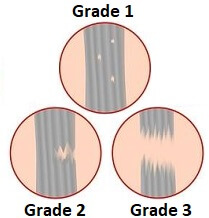
With a grade 1 calf strain, only a few of the muscle fibres are damaged, up to approximately 10%.
Mild pain may be felt at the time of injury or may not develop until after activity has stopped. The calf may feel tight and painful to move and it may be accompanied by cramp.
Symptoms from a grade 1 pulled calf muscle usually last from a few days to a couple of weeks
Grade 2 Symptoms
With grade 2 muscle tears, more of the muscle fibres are damaged, between 10-90%, but the calf muscle is still intact
Grade 2 pulled calf muscle injuries tend to cause a moderate, sharp pain that is usually felt at the time of injury and there may be resultant swelling and bruising in the surrounding area.
The area will be painful when the
calf muscles contract or are stretched and the region is often tender to touch. The affected person will usually walk with a
limp due to pain and weakness. Symptoms of a grade 2 calf tear usually last 4-6 weeks
Grade 3 Symptoms
With a grade 3 there is a large tear where there is complete rupture of the calf muscle i.e. all the fibres are torn, or a complete rupture of one of the heads of gastrocnemius
When suffering from a completely torn calf muscle, pain will be severe and immediate. The person will be unable to walk on the affected leg.
There will be considerate bruising and swelling with a grade 3 calf tear. There may also be a bulge in the back of the calf just above where the rupture has taken place as the muscle tissue pings up into a lump.
Calf Strain Treatment
Treatment for a pulled calf muscle aims to prevent further injury, aid healing and ensure full recovery to prevent long-term problems.
Pulled calf muscle treatment usually includes:
- Rest: It is really important to rest for a few days after a pulled calf muscle to prevent further injury. You should avoid anything that overloads or stretches the injured calf muscle and may benefit from using crutches for a few days
- Ice Treatment: Regularly applying ice to a pulled calf muscle helps to reduce pain and swelling and can help speed up healing
- Compression: Wearing a compression support or tubigrip also help reduce swelling in the calf muscle and provides some support to help protect from further injury
- Elevation: Keeping the leg elevated when resting helps to stop excess fluid and blood pooling in the calf muscle which helps to reduce swelling
- Medication: Over-the-counter pain medication can help to reduce pain levels. Anti-inflammatories should be avoided for the first few days as they can actually slow down healing
- Heel Pads: Using heel lifts in your shoes helps to reduce the tension through the injured calf muscle, aiding healing and reducing the risk of further tearing
- Calf Exercises: Strengthening and stretching exercises are a vital part of pulled calf muscle treatment but is really important to follow a rehab program so you know what is safe to do when
- Physical Therapy: A physical therapist may carry out a range of treatments including cross friction massage and ultrasound, both of which help reduce pain and inflammation and help the torn calf muscle to heal properly without a build up in scar tissue and regain full strength and flexibility
- Surgery: Occasionally, surgery may be required for a completely torn calf muscle but this is rare
With the right combination of these treatments, most people make a full recovery for their pulled calf muscle in just a few weeks. But is important to know which of these treatments are right for you and how to do them correctly.
You can find out everything you need to know in the calf muscle tear treatment article.
Calf Strain Recovery Time
Recovery from a calf strain will depend on what level calf strain you have experienced and how well you stick to your rehab program.
- Grade 1 calf strain recovery time: typically 7-10 days
- Grade 2 calf strain recovery time: typically 4-6 weeks
- Grade 3 calf strain recovery time: Up to 3 months
Calf Muscle Tear Prevention
Whether you have suffered from a pulled calf muscle in the past or not, prevention is better than cure. By ensuring that your muscles are warmed up before commencing exercise, you reduce your risk of suffering from a calf muscle strain.
You also want to make sure you calf muscles are strong and flexible so that they can cope with strain you put them through:
- Strengthening Exercises: exercises to improve the strength and endurance of the calf muscles will reduce the chance of injury
- Stretching Exercises: regularly stretching your calf muscles, especially before and after exercise reduces the strain on the muscle and improves flexibility.
To find out how to effectively strengthen and stretch your calf muscles, visit the calf workout section on our sister site
What Else Can Help
Pulled calf muscle tear treatment should begin as soon as possible and continued until you have regain full strength, flexibility and endurance in the muscle.
Make sure you check out the calf muscle tear treatment guide to find out everything you need to know, such as how heel lift inserts can make a massive difference, when ice does and doesn't help and how to know when it's safe to start stretching.
A pulled calf muscle is the most common cause of calf pain, but there are other, potentially life threatening causes of calf pain - visit the calf muscle pain section to find out more.
You may also be interested in the following articles:
- Pain Below The Knee
- Swelling Below The Knee
- Calf Muscle Pain
- Front Knee Pain
- Knee Strengthening Exercises
Related Articles
References
1. The Journal of the Canadian Chiropractic Association: Diagnosis and rehabilitation of gastrocnemius muscle tear: a case report. December 2015
2. British Journal of Sports Medicine: Exact moment of a gastrocnemius muscle strain captured on video. June 2002
3. Harvard Health Publishing: Muscle Strain A to Z. December 2018
4. Current Reviews In Musculoskeletal Medicine: Gastrocnemius vs. soleus strain: How to differentiate and deal with calf muscle injuries. June 2009
Last Updated: April 30th, 2025
Next Review Due: April 30th, 2027
